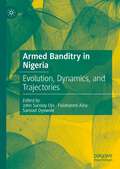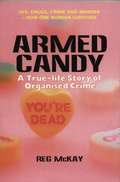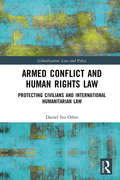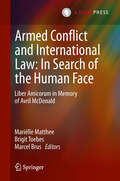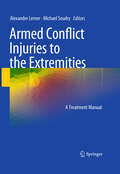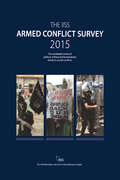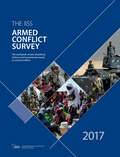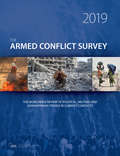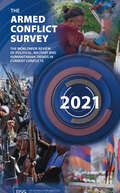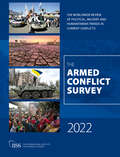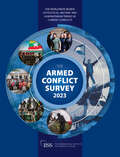- Table View
- List View
Armed Actors: Organized Violence and State Failure in Latin America
by Kees Koonings Dirk KruijtIn this volume, Latin Americanist scholars explore the recent evidence relating to the ways in which partial state failure in the continent is interacting with new types of organized violence, thereby undermining the process of democratic consolidation that has characterized Latin America over the past two decades. This 'new violence' stems - as this book's case studies from Colombia, Peru, Argentina, Venezuela, Brazil and other countries, including El Salvador, show - from a heterogeneous variety of social actors including drug mafias, peasant militias and urban gangs (collectively referred to as actores armadas), as well as state-related actors like the police, military intelligence agencies and paramilitary forces.These armed actors are reproducing organized social and political violence beyond the confines of democratic politics and civil society. The results, as the authors warn, include both 'governance voids' - domains where the legitimate state is effectively absent in the face of armed actors prevailing by force - and an erosion of the capacity and willingness of state officials themselves to abide by the rule of law. These tendencies, in turn, pave the way for a possible reinstallation of authoritarian regimes under the control of politicized armies or, at the very least, the spread of state violence in one form or another.Why these tendencies need to be taken so seriously is, the authors argue, because of the deeper social roots underlying them - notably the failure of neoliberal economic policies and weakened state structures to deliver the jobs, standards of living and social services every democratic citizenry has a right to expect. The Argentinian collapse and persistent Colombian and Venezuelan crises receive special attention in this regard.
Armed and Considered Dangerous: A Survey of Felons and Their Firearms
by Peter H. RossiArmed and Considered Dangerous is a book about "bad guys" and their guns. But Wright and Rossi contend that for every suspected criminal who owns and abuses a firearm, a hundred or more average citizens own guns for sport, for recreation, for self-protection, and for other reasons generally regarded as appropriate or legitimate. Armed and Considered Dangerous is the most ambitious survey ever undertaken of criminal acquisition, possession, and use of guns.There are vast differences between the average gun owner and the average gun-abusing felon, but the analyses reported here do not suggest any obvious way to translate these differences into gun control policies. Most policy implications drawn from the book are negative in character: this will not work for this reason, that will not work for that reason, and so on. When experts are asked, "Okay, then what will work?" they usually fall back on the old warhorses of poverty, the drug problem, or the inadequate resources of the criminal justice system, and otherwise have little to say. This is not a failure of social science. It simply asks more of the data than the data were ever intended to provide.Several of Wright and Rossi's findings have become "coin of the realm" in the gun control debate, cited frequently by persons who have long since forgotten where the data came from or what their limitations are. Several other findings, including many that are important, have been largely ignored. Still other findings have been superseded by better and more recent data or rendered anachronistic by intervening events. With the inclusion of a new introduction detailing recent statistics and updated information this new edition of Armed and Considered Dangerous is a rich source of information for all interested in learning about weapon behavior and ownership in America.
Armed and Considered Dangerous: A Survey of Felons and Their Firearms (Social Institutions And Social Change Ser.)
by Peter H. RossiArmed and Considered Dangerous is a book about "bad guys" and their guns. But Wright and Rossi contend that for every suspected criminal who owns and abuses a firearm, a hundred or more average citizens own guns for sport, for recreation, for self-protection, and for other reasons generally regarded as appropriate or legitimate. Armed and Considered Dangerous is the most ambitious survey ever undertaken of criminal acquisition, possession, and use of guns.There are vast differences between the average gun owner and the average gun-abusing felon, but the analyses reported here do not suggest any obvious way to translate these differences into gun control policies. Most policy implications drawn from the book are negative in character: this will not work for this reason, that will not work for that reason, and so on. When experts are asked, "Okay, then what will work?" they usually fall back on the old warhorses of poverty, the drug problem, or the inadequate resources of the criminal justice system, and otherwise have little to say. This is not a failure of social science. It simply asks more of the data than the data were ever intended to provide.Several of Wright and Rossi's findings have become "coin of the realm" in the gun control debate, cited frequently by persons who have long since forgotten where the data came from or what their limitations are. Several other findings, including many that are important, have been largely ignored. Still other findings have been superseded by better and more recent data or rendered anachronistic by intervening events. With the inclusion of a new introduction detailing recent statistics and updated information this new edition of Armed and Considered Dangerous is a rich source of information for all interested in learning about weapon behavior and ownership in America.
Armed and Devastating (The Precinct: Brotherhood of the Badge #2)
by Julie MillerProtective cop…virgin for the taking!
Armed and Famous: Risk Taker Cavanaugh Hero Armed And Famous Moving Target (Ivy Avengers #2)
by Jennifer MoreyThe guy next door turns into the sultry bodyguard in Jennifer Morey's Ivy Avengers miniseries.
Armed Banditry in Nigeria: Evolution, Dynamics, and Trajectories
by John Sunday Ojo Folahanmi Aina Samuel OyewoleIn Nigeria, armed banditry has emerged as a contemporary threat to national security. Commentators and scholars have repeatedly pointed to overlapping foci such as herders-farmers' conflicts, warlordism, ungoverned spaces, transnational criminal networks, and the proliferation of Small Arms and Light Weapons (SALW) from Libya as dynamics influencing the current security dilemma in Nigeria. The emergence of armed banditry has triggered the prevalence of everyday killings, kidnapping for ransom, property destruction, and cattle rustling. However, the group's origin remains obscure, while its objectives and organizational structure are fuzzy.This book aims to unravel the evolution, dynamics, and trajectories of armed banditry in Nigeria. As it explores the activities of armed banditry in Nigeria, the debate will focus on its historical context, socio-economic consequences, transnational dimensions, and the response to armed banditry in Nigeria. Furthermore, the book will explore whether the scourge of armed banditry represents a new terrorist organization with a distinct ideological orientation (if at all) or another non-state armed group creating and profiting from a criminal economy through the reign of terror. In response to the increasing concern for the criminal activities of armed banditry in Nigeria, the book anticipates unpacking its emerging trends and operational nomenclature.
Armed Candy: A True-Life Story of Organised Crime
by Reg McKayArmed Candy is the true story of one woman's struggle for survival on Britain's meanest streets. Kay has spent her whole life trying to escape. Sexually abused by her grandmother, she pleaded to return to her mother's care. But instead of finding a safe haven, Kay entered a world of drug abuse, swinging and dabbling in the occult. Although still a small child, she was soon buying drugs for her mother and being moved out of her bed as orgies ensued in her home. When she tried to escape, she ended up in a violent marriage, from which she fled in fear of her life. Turning to her mother for help, she was tricked into prostitution, her own mother acting much like a pimp. Kay became a high-class call girl, but then, through a chance meeting, she got involved with the most dangerous criminal gang in Glasgow. Women associated with such gangs are often seen as decorative arm candy, but Kay was admitted to the inner core, where she became involved in making decisions of life and death. She fell in love with the gang's equaliser, a young man feared throughout the country, and together they formed a formidable partnership. But they were too successful, and when they appeared to threaten some powerful interests they had to be taken out. The day that Kay's lover was gunned down in broad daylight saw the beginning of a reign of death in the city, as the organised crime world became paranoid and turned in on itself. For Kay, it was the beginning of her way out.
Armed Coexistence: The Dynamics of the Intractable Sino-Indian Border Dispute (Politics of South Asia)
by Stephen P. WestcottThis book is the first to comprehensively explore the origins and reasons behind the Sino-Indian border dispute’s intractability. Utilising an array of accurate maps, tables, archival and scholarly research, this book shows how an ambiguous frontier became a contested border and how it has become relatively pacified yet remaining unresolved. Unlike previous examinations, however, this book also provides a theoretically based explanation as to why it is so difficult for an interstate border dispute to be resolved. By examining a wide range of salient actors, from state leaders to the individual governing organisations to the State itself, it is shown that it is usually in their interest to maintain the status quo rather than seek some form of resolution, thereby ensuring that the border dispute remains intractable. With both China and India shaping up to be major powers throughout the twenty-first century, a detailed examination of the major issue of contention between them is more pertinent now than ever.
Armed Conflict and Forcible Displacement: Individual Rights under International Law (Routledge Research in International Law)
by Elena Katselli ProukakiThis book addresses the involuntary and arbitrary displacement of individuals resulting from armed conflict and gross human rights violations. It shows that forcible displacement constitutes a serious violation of international law and of fundamental community interests. Armed Conflict and Forcible Displacement provides a critical legal analysis of the contemporary international framework, permeating forcible displacement in these circumstances and explores the rights that individuals possess with specific focus on the right not to be displaced and, where this fails, the right to return home and to receive property restitution. In doing so, this volume marries together different fields of international law and builds on the case studies of Cyprus, Colombia, Cambodia and Syria. While the case studies considered here are far from exhaustive, they are either little explored or present significant challenges due to the magnitude of displacement or contested international jurisprudence. Through this analysis, the volume exposes some of the legal challenges that individuals encounter in being protected from forcible displacement, as well as the legal obstacles that persist in ensuring the return of and the recovery of property by the displaced. It will be of interest to those interested in the fields of international law, human rights law, as well as conflict and war studies.
Armed Conflict and Forcible Displacement: Individual Rights under International Law (Routledge Research in International Law)
by Elena Katselli ProukakiThis book addresses the involuntary and arbitrary displacement of individuals resulting from armed conflict and gross human rights violations. It shows that forcible displacement constitutes a serious violation of international law and of fundamental community interests. Armed Conflict and Forcible Displacement provides a critical legal analysis of the contemporary international framework, permeating forcible displacement in these circumstances and explores the rights that individuals possess with specific focus on the right not to be displaced and, where this fails, the right to return home and to receive property restitution. In doing so, this volume marries together different fields of international law and builds on the case studies of Cyprus, Colombia, Cambodia and Syria. While the case studies considered here are far from exhaustive, they are either little explored or present significant challenges due to the magnitude of displacement or contested international jurisprudence. Through this analysis, the volume exposes some of the legal challenges that individuals encounter in being protected from forcible displacement, as well as the legal obstacles that persist in ensuring the return of and the recovery of property by the displaced. It will be of interest to those interested in the fields of international law, human rights law, as well as conflict and war studies.
Armed Conflict and Human Rights Law: Protecting Civilians and International Humanitarian Law (Globalization: Law and Policy)
by Daniel Ivo OdonThis book explores developments in international law regarding the relationship between human rights law and international humanitarian law and their coapplicability in armed conflict situations. The work examines the jurisprudence of the international human rights courts and looks at the Inter-American and European Courts of Human Rights case law in dealing with new emergencies in armed conflicts. It argues that a new interpretation and application of the law is required to deal with current needs while remaining faithful to moral commitments made in the international arena. In this way, the book deals with recent cases and their rationale to build a new understanding of law and international policy that complies with the globalization process and progress towards an enhancement of the international community’s legal framework. Combining the emergencies in armed conflicts with the mutual enforcement of human rights law and humanitarian law, this book holistically develops concepts and theories to present a pragmatic solution to moral quandaries over the targeting of civilians during armed conflict situations. The book will be a valuable resource for academics, researchers and policy-makers in the areas of international human rights and international humanitarian law.
Armed Conflict and Human Rights Law: Protecting Civilians and International Humanitarian Law (Globalization: Law and Policy)
by Daniel Ivo OdonThis book explores developments in international law regarding the relationship between human rights law and international humanitarian law and their coapplicability in armed conflict situations. The work examines the jurisprudence of the international human rights courts and looks at the Inter-American and European Courts of Human Rights case law in dealing with new emergencies in armed conflicts. It argues that a new interpretation and application of the law is required to deal with current needs while remaining faithful to moral commitments made in the international arena. In this way, the book deals with recent cases and their rationale to build a new understanding of law and international policy that complies with the globalization process and progress towards an enhancement of the international community’s legal framework. Combining the emergencies in armed conflicts with the mutual enforcement of human rights law and humanitarian law, this book holistically develops concepts and theories to present a pragmatic solution to moral quandaries over the targeting of civilians during armed conflict situations. The book will be a valuable resource for academics, researchers and policy-makers in the areas of international human rights and international humanitarian law.
Armed Conflict and International Law: Liber Amicorum in Memory of Avril McDonald
by Mariëlle Matthee, Brigit Toebes and Marcel BrusThis book is written in memory of Avril McDonald, who passed away in April 2010. Avril was an inspired and passionate scholar in the fields of international humanitarian law, international criminal law, human rights law and law in the field of arms control and disarmament. What in particular made Avril’s work special, was her strong commitment with the human aspects throughout. Fourteen scholars and practitioners have contributed to this liber amicorum, which has led to a rich variety of topics within the disciplines of Avril’s expertise. They all have in common that they deal with the human perspectives of the discipline of law at hand. They concentrate on the impact of the developments in international law on humans, whether they are civilians, victims of war or soldiers. This human perspective of law makes this book an appropriate tribute to Avril McDonald and at the same time a unique and valuable contribution to international legal research in the present society. A society that becomes more and more characterized by detailed legal systems, defined by institutions that may frequently lack sufficient contact with the people concerned.
Armed Conflict Injuries to the Extremities: A Treatment Manual
by Alexander Lerner and Michael SoudryThis book is designed to meet the continued need to re-learn the principles of treatment of complex war injuries to the extremities in order to minimize post-traumatic and post-treatment complications and optimize functional recovery. Most of the chapters are based on the unique experience gained in the treatment of military personnel who have suffered modern combat trauma and civilian victims of terror attacks at a single, large level 1 trauma center. The remaining chapters present the experience of leading international authorities in trauma and reconstructive surgery. A staged treatment protocol is presented, ranging from primary damage control through to definitive functional limb reconstruction. The organization of medical aid, anesthesiology, diagnostic imaging, infection prophylaxis, and management of complications are reviewed, and a special chapter is devoted to the challenging dilemma of limb salvage versus amputation in the treatment of limbs at risk.
Armed Conflict Survey (Armed Conflict Survey Ser.)
by Nigel InksterThis book provides data on fatalities, refugees and separated people for all major armed conflicts in the Middle East, Sub-Saharan Africa, South Asia, Asia-Pacific, Europe and Eurasia, and Latin America in 2015, alongside in-depth analysis of their political, military and humanitarian dimensions.
Armed Conflict Survey (Armed Conflict Survey Ser.)
by The International The International Institute for Strategic Studies (IISS),This book provides data on fatalities, refugees and separated people for all major armed conflicts in the Middle East, Sub-Saharan Africa, South Asia, Asia-Pacific, Europe and Eurasia, and Latin America in 2015, alongside in-depth analysis of their political, military and humanitarian dimensions.
Armed Conflict Survey 2017 (Armed Conflict Survey Ser.)
by The International Institute for Strategic StudiesThe Armed Conflict Survey provides in-depth analysis of the political, military and humanitarian dimensions of all major armed conflicts, as well as data on fatalities, refugees and internally displaced persons. Compiled by the IISS, publisher of The Military Balance, it is the standard reference work on contemporary conflict. The book assesses key developments in 36 conflicts, including those in Iraq, Syria, Afghanistan, South Sudan, Israel–Palestine, Southern Thailand, Colombia and Ukraine.The Armed Conflict Survey also features chapters on UN peacekeeping; sexual violence; the Islamic State’s shifting narrative; governance by armed groups and rebel-to-party transitions.
Armed Conflict Survey 2017 (Armed Conflict Survey Ser.)
by The International The International Institute for Strategic Studies (IISS),The Armed Conflict Survey provides in-depth analysis of the political, military and humanitarian dimensions of all major armed conflicts, as well as data on fatalities, refugees and internally displaced persons. Compiled by the IISS, publisher of The Military Balance, it is the standard reference work on contemporary conflict. The book assesses key developments in 36 conflicts, including those in Iraq, Syria, Afghanistan, South Sudan, Israel–Palestine, Southern Thailand, Colombia and Ukraine.The Armed Conflict Survey also features chapters on UN peacekeeping; sexual violence; the Islamic State’s shifting narrative; governance by armed groups and rebel-to-party transitions.
Armed Conflict Survey 2019
by The International Institute for Strategic StudiesThe Armed Conflict Survey provides in-depth analysis of the political, military and humanitarian dimensions of all major armed conflicts, as well as data on fatalities, refugees and internally displaced persons. Compiled by the IISS, publisher of The Military Balance, it is the standard reference work on contemporary conflict. The book assesses key developments in 36 high-, medium- and low-intensity conflicts, including those in Iraq, Syria, Afghanistan, South Sudan, Israel–Palestine, Southern Thailand, Colombia and Ukraine. The Armed Conflict Survey features essays by some of the world’s leading experts on armed conflict, including Mats Berdal, Elisabeth Jean Wood, Julia Bleckner, Nelly Lahoud, William Reno and Carrie Manning. They write on: • UN peacekeeping; • conflict-related sexual violence; • the Islamic State’s shifting narrative; • the changing foundations of governance by armed groups; and • rebel-to-party transitions. The authors’ discussion of principal thematic and cross-national trends complements the detailed analysis of each conflict at the core of the book. The Armed Conflict Survey also includes maps, infographics and multi-year data, as well as the IISS Chart of Conflict.
Armed Conflict Survey 2019
by The International The International Institute for Strategic Studies (IISS)The Armed Conflict Survey provides in-depth analysis of the political, military and humanitarian dimensions of all major armed conflicts, as well as data on fatalities, refugees and internally displaced persons. Compiled by the IISS, publisher of The Military Balance, it is the standard reference work on contemporary conflict. The book assesses key developments in 36 high-, medium- and low-intensity conflicts, including those in Iraq, Syria, Afghanistan, South Sudan, Israel–Palestine, Southern Thailand, Colombia and Ukraine. The Armed Conflict Survey features essays by some of the world’s leading experts on armed conflict, including Mats Berdal, Elisabeth Jean Wood, Julia Bleckner, Nelly Lahoud, William Reno and Carrie Manning. They write on: • UN peacekeeping; • conflict-related sexual violence; • the Islamic State’s shifting narrative; • the changing foundations of governance by armed groups; and • rebel-to-party transitions. The authors’ discussion of principal thematic and cross-national trends complements the detailed analysis of each conflict at the core of the book. The Armed Conflict Survey also includes maps, infographics and multi-year data, as well as the IISS Chart of Conflict.
Armed Conflict Survey 2021
by The International Institute for Strategic StudiesThe Armed Conflict Survey is the annual review of the political, military and humanitarian dimensions of all active conflicts from the International Institute for Strategic Studies. It offers in-depth analysis of the drivers, dynamics and outlook of 34 current armed conflicts along with detailed information on conflict parties and more than 60 full-colour maps and infographics. The Armed Conflict Survey is an essential resource for those involved in security, foreign and humanitarian policymaking, and an indispensable handbook for anyone conducting serious analysis of armed conflict. Key features · Essays on global trends in armed conflict, with a focus on the changing nature of third-party intervention, the long aftermath of armed conflicts, and economic migration and forced displacement in a COVID-19 world. · Overviews of key events and political and military developments from January 2020–February 2021 for each conflict. · Strategic analysis of national and regional drivers and conflict outlooks. · Regional analyses with unique insights into the geopolitical and geo-economic threads linking conflicts across regions and globally. · Expanded information on conflict parties. · The Armed Conflict Global Relevance Indicator (ACGRI), an IISS proprietary indicator that combines measures of incidence and human impact with geopolitical impact to assess the global salience of armed conflicts. · Analysis of the humanitarian, social and economic impact of conflicts. · Conflict-specific trends, strategic implications and prospects for peace. · More than 60 full-colour maps, tables and infographics highlighting key conflict developments and data. · Key statistics on violent events, fatalities, military power, geopolitical salience, refugees and internally displaced persons. · The 2021 Chart of Armed Conflict, presenting information on conflict start dates, typologies and relevant refugee flows, as well as providing a visual overview of each conflict’s geopolitical relevance, looking at 2020 UN Security Council resolutions, multilateral missions and the involvement of third-party countries.
Armed Conflict Survey 2021
by The International The International Institute for Strategic Studies (IISS)The Armed Conflict Survey is the annual review of the political, military and humanitarian dimensions of all active conflicts from the International Institute for Strategic Studies. It offers in-depth analysis of the drivers, dynamics and outlook of 34 current armed conflicts along with detailed information on conflict parties and more than 60 full-colour maps and infographics. The Armed Conflict Survey is an essential resource for those involved in security, foreign and humanitarian policymaking, and an indispensable handbook for anyone conducting serious analysis of armed conflict. Key features · Essays on global trends in armed conflict, with a focus on the changing nature of third-party intervention, the long aftermath of armed conflicts, and economic migration and forced displacement in a COVID-19 world. · Overviews of key events and political and military developments from January 2020–February 2021 for each conflict. · Strategic analysis of national and regional drivers and conflict outlooks. · Regional analyses with unique insights into the geopolitical and geo-economic threads linking conflicts across regions and globally. · Expanded information on conflict parties. · The Armed Conflict Global Relevance Indicator (ACGRI), an IISS proprietary indicator that combines measures of incidence and human impact with geopolitical impact to assess the global salience of armed conflicts. · Analysis of the humanitarian, social and economic impact of conflicts. · Conflict-specific trends, strategic implications and prospects for peace. · More than 60 full-colour maps, tables and infographics highlighting key conflict developments and data. · Key statistics on violent events, fatalities, military power, geopolitical salience, refugees and internally displaced persons. · The 2021 Chart of Armed Conflict, presenting information on conflict start dates, typologies and relevant refugee flows, as well as providing a visual overview of each conflict’s geopolitical relevance, looking at 2020 UN Security Council resolutions, multilateral missions and the involvement of third-party countries.
Armed Conflict Survey 2022
by The International Institute for Strategic StudiesThe Armed Conflict Survey 2022 provides an exhaustive review of the political, military and humanitarian dimensions of 33 active armed conflicts globally in the period from 1 March 2021 to 30 April 2022. The review is complemented by a strategic analysis of national, regional and global drivers and conflict outlooks, providing unique insights into the geopolitical and geo-economic threads linking conflicts across the world, as well as into emerging flashpoints and political risks. This edition includes a special feature on climate security given the increasingly urgent need to understand the complex interlinkages between climate change, climate vulnerability and conflict amid accelerating global warming. Reflecting the growing importance of geopolitical factors in the current global conflict landscape, The Armed Conflict Survey 2022 features the IISS Armed Conflict Global Relevance Indicator, which compares the global relevance of armed conflicts in terms of their geopolitical impact, as well as their human impact and intensity. This edition also includes maps, infographics and key statistics, as well as the accompanying Chart of Armed Conflict.
Armed Conflict Survey 2022
The Armed Conflict Survey 2022 provides an exhaustive review of the political, military and humanitarian dimensions of 33 active armed conflicts globally in the period from 1 March 2021 to 30 April 2022. The review is complemented by a strategic analysis of national, regional and global drivers and conflict outlooks, providing unique insights into the geopolitical and geo-economic threads linking conflicts across the world, as well as into emerging flashpoints and political risks. This edition includes a special feature on climate security given the increasingly urgent need to understand the complex interlinkages between climate change, climate vulnerability and conflict amid accelerating global warming. Reflecting the growing importance of geopolitical factors in the current global conflict landscape, The Armed Conflict Survey 2022 features the IISS Armed Conflict Global Relevance Indicator, which compares the global relevance of armed conflicts in terms of their geopolitical impact, as well as their human impact and intensity. This edition also includes maps, infographics and key statistics, as well as the accompanying Chart of Armed Conflict.
Armed Conflict Survey 2023
by The International Institute for Strategic StudiesThe Armed Conflict Survey 2023 provides an exhaustive review of the political, military and humanitarian dimensions of active armed conflicts globally in the period from 1 May 2022–30 June 2023. The review is complemented by a strategic analysis of regional and global drivers and conflict outlooks, providing unique insights into the geopolitical and geo-economic threads linking conflicts regionally and globally, as well as into emerging flashpoints and political risks to monitor. This edition’s regional-focused approach also includes Regional Spotlight chapters on selected key conflict trends of regional and global importance. Reflecting the growing significance of geopolitical factors in shaping current conflict trends across the world, The Armed Conflict Survey 2023 features the third edition of the IISS Armed Conflict Global Relevance Indicator, which compares the global relevance of armed con□ icts in terms of their geopolitical impact, as well as their human impact and intensity. This edition also includes maps, infographics, key statistics and the accompanying Chart of Armed Con□flict.




